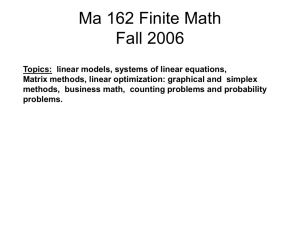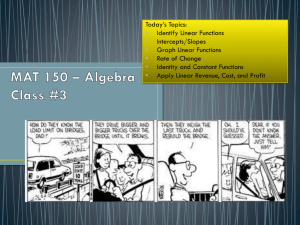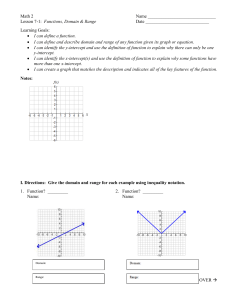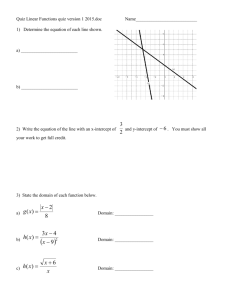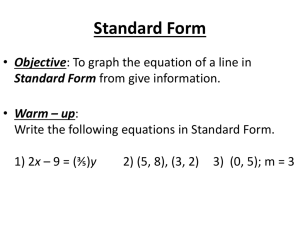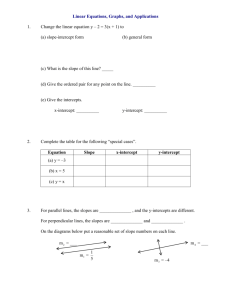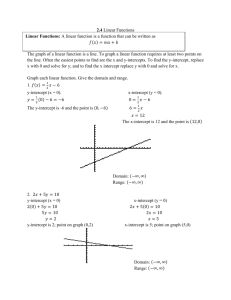Activity 2
advertisement
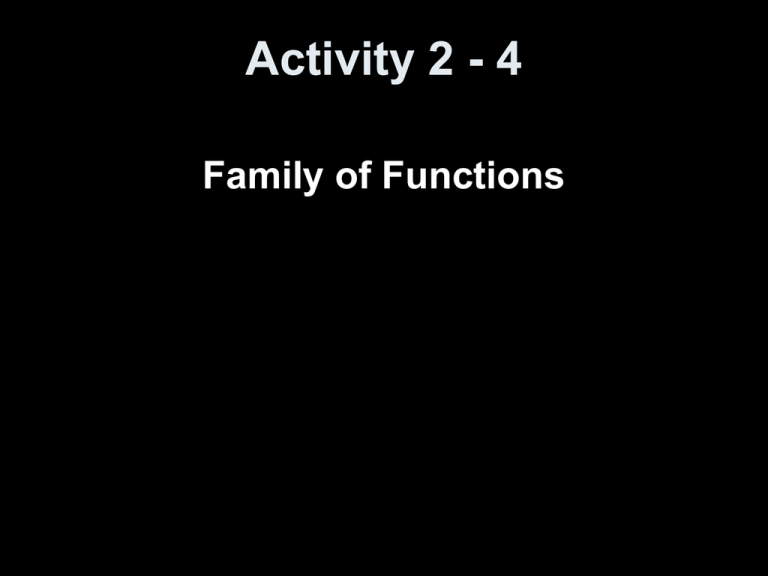
Activity 2 - 4 Family of Functions 5-Minute Check on Activity 2-3 1. What is the formula for slope-intercept form of a line? y y2 – y1 Slope = m = ---------- = -------------x x2 – x1 y = mx + b 2. How do you find the y-intercept of a line? Plug x = 0 into the equation and solve for y = 3. How do you find the x-intercept of a line? Plug y = 0 into the equation and solve for x = 4. How can we use our calculator to find the intercepts? y-intercept: look for the x=0 value in the table (2nd graph) X-intercept:: use 2nd trace (calculate) option 2: zeros to let the calculator estimate an x-intercept Click the mouse button or press the Space Bar to display the answers. Objectives • Identify the effect of changes in the equation of a line on its graph • Identify the effect of changes in the graph of a line on its equation • Identify the change in the graph and the equation of a basic function as a translation, reflection or vertical stretch or shrink Vocabulary • Vertical Shift – a constant is added (shift up) or subtracted (shift down) to each output value • Horizontal Shift – a constant is added (shift left) or subtracted (shift right) to each input value • Reflection – a flip across an axis; algebraically a reflection across the x-axis occurs if y = f(x) = f(-x) • Stretch Factor – is called a; when the graph of y = f(x) changes to y = af(x) • Vertical Stretch – when the graph of y = f(x) changes to y = af(x) and |a| > 1 • Vertical Shrink – when the graph of y = f(x) changes to y = af(x) and 0 < |a| < 1 • Transformations – any translations (horizontal or vertical shifts), reflections and vertical stretches or shrinks Activity A primary objective of this textbook is to help you develop a familiarity with the graphs, equations, and properties of a variety of functions, including linear, quadratic, exponential, and logarithmic. You will group these functions into families and identify the similarities within a family and the differences between families. We will continue to explore the family of linear functions. Vertical Shifts Revisited y Given y = f(x) = 2x Graph the function x Determine the slope and intercepts m=2 y-intercept = 0 x-intercept = 0 Graph Y2 = 2x – 3 and Y3 = 2x + 4 Compare the graphs (slope and intercepts) m=2 y-intercept = -3 x-intercept = 3/2 m=2 y-intercept = 4 x-intercept = -2 Horizontal Shifts Revisited y Given y = f(x) = 2x Graph the function x Determine the slope and intercepts m=2 y-intercept = 0 x-intercept = 0 Graph Y2 = 2(x – 3) and Y3 = 2(x + 3) Compare the graphs (slope and intercepts) m=2 y-intercept = -6 x-intercept = 3 m=2 y-intercept = 6 x-intercept = -3 Both Shifts Graph each of the following functions in the same window. Y1 = x2 Y2 = x2 + 6 Y3 = (x + 3)2 How do the graphs compare? Which is shifted horizontally? Y3 = (x + 3)2 What direction? left Which is shifted vertically? Y2 = x2 + 6 What direction? up y x Reflections Across the X-Axis • The graph of y = -x is a reflection of the graph of y = x across the x-axis • In general, if the graph of y = f(x) is reflected across the x-axis, then the equation of the resulting graph is y = -f(x) • The reflection is keeping the x-value the same and multiplying the output value, y, by negative one. X-Axis Reflections y Given y = f(x) = 3x + 6 Graph the function Determine the slope and intercepts m=3 y-intercept = 6 x-intercept = -2 Reflect the graph across the x-axis Write the equation of the reflection y = -3x - 6 Determine the slope and intercepts m = -3 y-intercept = -6 x-intercept = -2 x Reflections Across the Y-Axis • The graph of y = -x is also a reflection of the graph of y = x across the y-axis • In general, if the graph of y = f(x) is reflected across the y-axis, then the equation of the resulting graph is y = f(-x) • The reflection is keeping the y-value the same and multiplying the input value, x, by negative one. Y-Axis Reflections y Given y = f(x) = 3x + 6 Graph the function Determine the slope and intercepts m=3 y-intercept = 6 x-intercept = -2 Reflect the graph across the y-axis – find f(-x) Write the equation of the reflection y = -3x + 6 Determine the slope and intercepts m = -3 y-intercept = 6 x-intercept = 2 x Vertical Stretches and Shrinks • • • • A graph is stretched vertically when the function (output value) is multiplied by a constant, a > 1 A graph is shrunk vertically when the function (output value) is multiplied by a constant, 0 < a < 1 A graph is flipped and stretched vertically when the function (output value) is multiplied by a constant, a < -1 A graph is flipped and shrunk vertically when the function (output value) is multiplied by a constant, -1 < a < 0 Vertical Stretches y Given y = f(x) = x Graph the function x Determine the slope and intercepts m=1 y-intercept = 0 x-intercept = 0 Graph Y2 = 2x and Y3 = 5x Compare the three graphs: (slope and intercepts) m=2 y-intercept = 0 x-intercept = 0 m=5 y-intercept = 0 x-intercept = 0 Transformations y Given y = f(x) = |x| Graph the function Graph Y2 = |x + 3| Graph Y3 = 2|x + 3| Graph Y4 = -2|x + 3| x Summary and Homework • Summary – Vertical shifts: output value ± constant – Horizontal shifts: (input value ± constant) – Reflections: • x-axis: x-values same, y-values flip sign • y-axis: y-values same, x-values flip sign – Shifts (also called translations), reflections (flips) and vertical stretches and shrinks are called Transformations • Homework – Pg 215-7; 1 - 7

